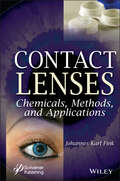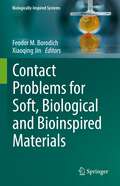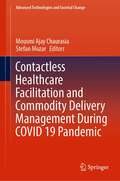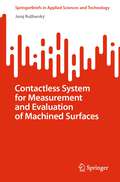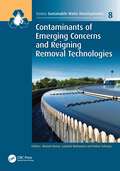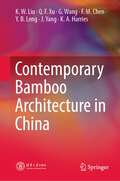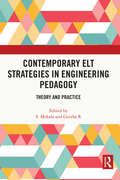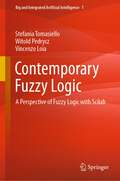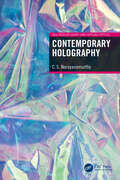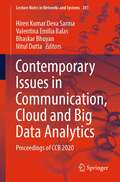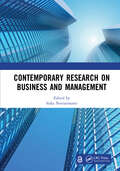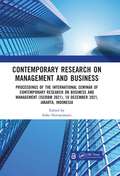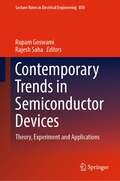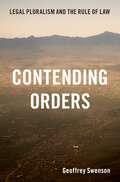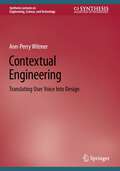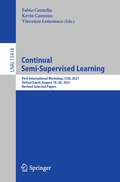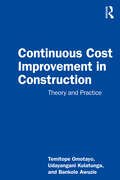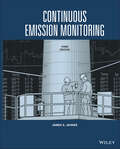- Table View
- List View
Contact Lenses: Chemicals, Methods, and Applications
by Johannes Karl FinkCONTACT LENSES The book focuses on the chemistry and properties of contact lenses and their fabrication methods. With research & development continuing in the field, this comprehensive book takes a look at the last 10 years in terms of new materials, chemistry methods, applications, and fabrication techniques. New applications include drug delivery, lenses for augmented reality, electronic contact lenses, and wearable smart contact lenses. In addition, the book discusses simulation methods for contact lenses, such as ocular topography parameters, gas permeable lenses, and computerized videokeratography. On the fabrication front, several common fabrication methods for contact lenses are detailed, including the computer-aided contact lens design, methods for the fabrication of colored contact lenses, and the fabrication of decentered contact lenses. Special processes are reviewed, including, mold processes, reactive ion etching, electrospinning, and others. Also discussed are the properties of contact lenses and methods for the measurement. Many of the standard methods are discussed, but other issues are taken up too including a discussion on the assessment of cytotoxic effects, the Schirmer tear test, and others. The book concludes with a chapter detailing the possible medical problems related to contact lenses and how to avoid them. These include eye diseases, allergic and toxic reactions, as well as methods for medical treatment such as disinfection agents. Audience The book will be used by chemists, polymer scientists, ophthalmologists, engineers in the contact lens industry as well as polymer industries.
Contact Problems for Soft, Biological and Bioinspired Materials (Biologically-Inspired Systems #15)
by Feodor M. Borodich Xiaoqing JinThis book contains contributions from leading researchers in biomechanics, nanomechanics, tribology, contact mechanics, materials science and applications on various experimental techniques including atomic force microscopy (AFM) for studying soft, biomimetic and biological materials and objects. Biologists, physicists, researchers applying methods of contact mechanics and researchers testing materials using indentation techniques along with many other applied scientists will find this book a useful addition to their libraries. Moreover, several reviews in this book are written as introductions to several important and rather sophisticated research areas such as depth-sensing indentation, studying of biological cells by AFM probes, mechanics of adhesive contact and contact between viscoelastic (hereditary elastic) solids. The book containing new theoretical models, results of experimental studies and numerical simulations, along with reviews of above mentioned areas of contact mechanics in application to biological systems, would be beneficial for researchers in many areas of biology, medicine, engineering, mechanics and biomimetics.
Contactless Healthcare Facilitation and Commodity Delivery Management During COVID 19 Pandemic (Advanced Technologies and Societal Change)
by Mousmi Ajay Chaurasia Stefan MozarThis book offers concepts related to communication engineering principles to fight the current Covid situation, by developing contactless need-based solutions. COVID-19, a global pandemic makes us rethink how governments, organizations, and societies around the world can work with minimum or without physical contact. Technologies like artificial intelligence and big data are playing an essential role in responding to the COVID-19 pandemic. This book is a combination of chapters related to imaging and detective technologies used by the experts to fight the COVID-19 pandemic and a combination of interesting content covering the need of hour solutions generated through cutting edge technologies. In the absence of a proper medicine or vaccine, it is quite evident that nutrition plays an important role in the quick recovery of covid patients which must be very carefully planned with proper diagnostics. Data analysis and X-Ray/CT Image analysis by next-generation techniques like deep sensing, machine learning is interesting and useful for research and applied healthcare professionals. Research findings with a focus on diagnostics and reports generated through important data analysis in the book are quite useful and can be referred to by researchers and professionals working in the area of cutting-edge technologies against COVID 19.
Contactless System for Measurement and Evaluation of Machined Surfaces (SpringerBriefs in Applied Sciences and Technology)
by Juraj RužbarskýThis book presents a contactless system for the measurement and evaluation of selected characteristics of machined surfaces. It describes the design and construction of new equipment designed for contactless characterization of surface geometry working based on laser profilometry by triangulation principle. The book focuses on the quality assessment of surfaces produced by the technology of abrasive waterjet cutting (AWJ) and by laser. The author analyses the performed experiment of measurement of machined surfaces of samples of aluminum, stainless steel, and constructional steel using the contactless method with the LPM system and contact method using Mitutoyo SJ 400 surface roughness tester.
Contaminants of Emerging Concerns and Reigning Removal Technologies (Sustainable Water Developments - Resources, Management, Treatment, Efficiency and Reuse #8)
by Manish Kumar Sanjeeb Mohapatra Kishor AcharyaWith an increased demand for wastewater reuse, groundwater recharge with treated wastewater has been practiced across the globe. As a result, groundwater quality deteriorates by emerging micropollutants from various anthropogenic origins, including untreated wastewater, seepage of landfill leachate, and runoff from agricultural lands. The fate of such emerging and geogenic contaminants in subsurface systems, especially in the groundwater, depends on several factors. Physicochemical properties of contaminants such as octanol-water partition coefficient, dissociation constant, water solubility, susceptibility to biodegradation under anaerobic conditions, and environmental persistence under diverse geological and pH conditions play a critical role during subsurface mass flow. Thus, advanced wastewater treatment techniques, followed by implementing stricter guidelines, are some of the measures that can safeguard water resources. This book, in general, gives an understanding of the fate and mitigation strategies for emerging and geogenic contaminants in the groundwater. The first and second sections provide a detailed insight into various removal techniques and mitigation approaches. Possible treatment strategies, including bioremediation and natural attenuation, are also covered in those sections. Environmental assessment, groundwater vulnerability, health effects, and regulations pertaining to various contaminants are systematically presented in the third section.
Contaminants of Emerging Concerns and Reigning Removal Technologies (Sustainable Water Developments - Resources, Management, Treatment, Efficiency and Reuse #8)
by Manish KumarWith an increased demand for wastewater reuse, groundwater recharge with treated wastewater has been practiced across the globe. As a result, groundwater quality deteriorates by emerging micropollutants from various anthropogenic origins, including untreated wastewater, seepage of landfill leachate, and runoff from agricultural lands. The fate of such emerging and geogenic contaminants in subsurface systems, especially in the groundwater, depends on several factors. Physicochemical properties of contaminants such as octanol-water partition coefficient, dissociation constant, water solubility, susceptibility to biodegradation under anaerobic conditions, and environmental persistence under diverse geological and pH conditions play a critical role during subsurface mass flow. Thus, advanced wastewater treatment techniques, followed by implementing stricter guidelines, are some of the measures that can safeguard water resources. This book, in general, gives an understanding of the fate and mitigation strategies for emerging and geogenic contaminants in the groundwater. The first and second sections provide a detailed insight into various removal techniques and mitigation approaches. Possible treatment strategies, including bioremediation and natural attenuation, are also covered in those sections. Environmental assessment, groundwater vulnerability, health effects, and regulations pertaining to various contaminants are systematically presented in the third section.
Contemporary Bamboo Architecture in China
by K. W. Liu Q. F. Xu G. Wang F. M. Chen Y. B. Leng J. Yang K. A. HarriesThis book describes the distribution of bamboo forest and bamboo species for construction, the types and characteristics of both engineered and natural full-culm bamboo materials for construction, the development history and research status of different forms of bamboo architecture. We go on to describe standards, relevant international organizations, research institutions and production and processing enterprises and typical cases. Starting from six aspects, this book systematically describes modern bamboo building development, analyzes the opportunities and challenges faced by the bamboo construction industry and provides guidance for the development of the bamboo construction industry in China. Particularly in Chapter 6, more than 70 examples constructed mostly since 2014 are selected to provide a detailed overview of the use of bamboo as decorative and structural materials. In order to fully explore the potential of bamboo in engineering applications, the authors introduce the use of bamboo construction for transportation facilities (bridges, highway landscape fences and bus stations), landscape, water pipelines and urban municipal tunnels. The authors hope readers are inspired by these most vivid cases and experience the charm of modern Chinese bamboo architecture.
Contemporary ELT Strategies in Engineering Pedagogy: Theory and Practice
by S. Mekala and Geetha RThis book explores innovative pedagogical practices and teaching and learning strategies in the engineering curriculum for empowered learning. It highlights the urgency for developing specific skill sets among students that meet the current market recruitment needs. The authors present a detailed framework for fostering a higher level of competence in students especially in their communication skills, their knowledge of media and technology tools, and their leadership skills. The book offers examples of new and effective teaching strategies including cognitive, metacognitive, and socio-affective strategies which align well with the existing and evolving technical curriculum. The book will be of interest to teachers, students, and researchers of education, engineering, and higher education. It will also be useful for English language teachers, educators, and curriculum developers.
Contemporary ELT Strategies in Engineering Pedagogy: Theory and Practice
by S. Mekala Geetha RThis book explores innovative pedagogical practices and teaching and learning strategies in the engineering curriculum for empowered learning. It highlights the urgency for developing specific skill sets among students that meet the current market recruitment needs. The authors present a detailed framework for fostering a higher level of competence in students especially in their communication skills, their knowledge of media and technology tools, and their leadership skills. The book offers examples of new and effective teaching strategies including cognitive, metacognitive, and socio-affective strategies which align well with the existing and evolving technical curriculum. The book will be of interest to teachers, students, and researchers of education, engineering, and higher education. It will also be useful for English language teachers, educators, and curriculum developers.
Contemporary Fuzzy Logic: A Perspective of Fuzzy Logic with Scilab (Big and Integrated Artificial Intelligence #1)
by Witold Pedrycz Vincenzo Loia Stefania TomasielloThis book offers an essential introduction to fuzzy logic, starting with the classical notions and going through more advanced notions from the current state-of-the-art research. Each of the major topics is accompanied by examples, problems and Scilab codes. As a free open source software, Scilab offers everyone the chance to practice the concepts learned through the book. The book represents a synthesis of authors’ research and experience through the lectures delivered to university students. It is primarily intended as a textbook for upper-level undergraduates and graduates in computer science, mathematics, physics and engineering. It also represents a valuable resource for practitioners and researchers alike, bringing ideas for projects in the broad field of fuzzy logic.
Contemporary Holography (Multidisciplinary and Applied Optics)
by C. S. NarayanamurthyThis book is unique in covering most of the developments on optical holographic techniques since holography’s invention in 1947 by Dennis Gabor. Starting from conventional holography with photopolymer recording techniques to CCD(Charge Coupled Device)-based digital holography, this book covers the spectrum of contemporary holographic techniques. The first chapter deals with conventional holographic methods using photographic plates in both in-line Gabor holography and off-axis holography. Then the second chapter covers principle and experimental techniques of the Conoscopic holography technique, and the third chapter deals with Computer generated holography. The fourth chapter discusses basic principles of dynamic holography using photorefractive crystals where the theory and experiments show how the photorefractive effect is used for dynamic recording of holograms. The fifth and sixth chapters extensively discuss the fundamentals of digital holography and unconventional coherence holography. In digital holography, two types of phase shifting methods which are dynamic and geometric phase shifting digital holographic techniques are elaborated with practical examples. Then, in the sixth chapter, the unconventional coherence holographic method describes a new holography using incoherent light sources. This book is intended for advanced undergraduate and first-year graduate-level students, as well as researchers looking for a complete resource in holography techniques.
Contemporary Holography (Multidisciplinary and Applied Optics)
by C. S. NarayanamurthyThis book is unique in covering most of the developments on optical holographic techniques since holography’s invention in 1947 by Dennis Gabor. Starting from conventional holography with photopolymer recording techniques to CCD(Charge Coupled Device)-based digital holography, this book covers the spectrum of contemporary holographic techniques. The first chapter deals with conventional holographic methods using photographic plates in both in-line Gabor holography and off-axis holography. Then the second chapter covers principle and experimental techniques of the Conoscopic holography technique, and the third chapter deals with Computer generated holography. The fourth chapter discusses basic principles of dynamic holography using photorefractive crystals where the theory and experiments show how the photorefractive effect is used for dynamic recording of holograms. The fifth and sixth chapters extensively discuss the fundamentals of digital holography and unconventional coherence holography. In digital holography, two types of phase shifting methods which are dynamic and geometric phase shifting digital holographic techniques are elaborated with practical examples. Then, in the sixth chapter, the unconventional coherence holographic method describes a new holography using incoherent light sources. This book is intended for advanced undergraduate and first-year graduate-level students, as well as researchers looking for a complete resource in holography techniques.
Contemporary Issues in Communication, Cloud and Big Data Analytics: Proceedings of CCB 2020 (Lecture Notes in Networks and Systems #281)
by Hiren Kumar Deva Sarma Valentina Emilia Balas Bhaskar Bhuyan Nitul DuttaThis book presents the outcomes of the First International Conference on Communication, Cloud, and Big Data (CCB) held on December 18–19, 2020, at Sikkim Manipal Institute of Technology, Majitar, Sikkim, India. This book contains research papers and articles in the latest topics related to the fields like communication networks, cloud computing, big data analytics, and on various computing techniques. Research papers addressing security issues in above-mentioned areas are also included in the book. The research papers and articles discuss latest issues in the above-mentioned topics. The book is very much helpful and useful for the researchers, engineers, practitioners, research students, and interested readers.
Contemporary Research on Business and Management: Proceedings of the International Seminar of Contemporary Research on Business and Management (ISCRBM 2020), 25-27 November 2020, Surabaya, Indonesia
by Siska NoviaristantiThis book contains selected papers presented at the 4th International Seminar of Contemporary Research on Business and Management (ISCRBM 2020), which was organized by the Alliance of Indonesian Master of Management Program (APMMI) and held in Surubaya, Indonesia, 25-27 November 2020. It was hosted by the Master of Management Program Indonesia University and co-hosts Airlangga University, Sriwijaya University, Trunojoyo University of Madura, and Telkom University, and supported by Telkom Indonesia and Triputra. The seminar aimed to provide a forum for leading scholars, academics, researchers, and practitioners in business and management area to reflect on current issues, challenges and opportunities, and to share the latest innovative research and best practice. This seminar brought together participants to exchange ideas on the future development of management disciplines: human resources, marketing, operations, finance, strategic management and entrepreneurship.
Contemporary Research on Business and Management: Proceedings of the International Seminar of Contemporary Research on Business and Management (ISCRBM 2020), 25-27 November 2020, Surabaya, Indonesia
by Siska NoviaristantiThis book contains selected papers presented at the 4th International Seminar of Contemporary Research on Business and Management (ISCRBM 2020), which was organized by the Alliance of Indonesian Master of Management Program (APMMI) and held in Surubaya, Indonesia, 25-27 November 2020. It was hosted by the Master of Management Program Indonesia University and co-hosts Airlangga University, Sriwijaya University, Trunojoyo University of Madura, and Telkom University, and supported by Telkom Indonesia and Triputra. The seminar aimed to provide a forum for leading scholars, academics, researchers, and practitioners in business and management area to reflect on current issues, challenges and opportunities, and to share the latest innovative research and best practice. This seminar brought together participants to exchange ideas on the future development of management disciplines: human resources, marketing, operations, finance, strategic management and entrepreneurship.
Contemporary Research on Management and Business: Proceedings of the International Seminar of Contemporary Research on Business and Management (ISCRBM 2021), 18 December 2021, Jakarta, Indonesia
by Siska NoviaristantiThis book contains 74 selected papers presented at the 5th International Seminar of Contemporary Research on Business and Management (ISCRBM 2021), which was organized by the Alliance of Indonesian Master of Management Program (APMMI) and held in Jakarta, Indonesia on 18 December 2021. This online conference was hosted by the Master of Management Program of Indonesia University. This year, ISCRBM focused on research related to driving sustainable business through innovation. Business has had to deal with the Covid-19 pandemic, so a new approach towards managing business to survive competition is indispensable. Innovation is the key for all organizations in surviving in the new normal and beyond. The Seminar aimed to provide a forum for leading scholars, academics, researchers, and practitioners in the business and management area to reflect on the issues, challenges and opportunities, and to share the latest innovative research and best practices. This seminar brought together participants to exchange ideas on the future development of management disciplines: human resource, marketing, operation, finance, strategic management and entrepreneurship.
Contemporary Research on Management and Business: Proceedings of the International Seminar of Contemporary Research on Business and Management (ISCRBM 2021), 18 December 2021, Jakarta, Indonesia
by Siska NoviaristantiThis book contains 74 selected papers presented at the 5th International Seminar of Contemporary Research on Business and Management (ISCRBM 2021), which was organized by the Alliance of Indonesian Master of Management Program (APMMI) and held in Jakarta, Indonesia on 18 December 2021. This online conference was hosted by the Master of Management Program of Indonesia University. This year, ISCRBM focused on research related to driving sustainable business through innovation. Business has had to deal with the Covid-19 pandemic, so a new approach towards managing business to survive competition is indispensable. Innovation is the key for all organizations in surviving in the new normal and beyond. The Seminar aimed to provide a forum for leading scholars, academics, researchers, and practitioners in the business and management area to reflect on the issues, challenges and opportunities, and to share the latest innovative research and best practices. This seminar brought together participants to exchange ideas on the future development of management disciplines: human resource, marketing, operation, finance, strategic management and entrepreneurship.
Contemporary Trends in Semiconductor Devices: Theory, Experiment and Applications (Lecture Notes in Electrical Engineering #850)
by Rupam Goswami Rajesh SahaThis book covers evolution, concept and applications of modern semiconductor devices such as tunnel field effect transistors (TFETs), vertical super-thin body MOSFETs, ion sensing FETs (ISFETs), non-conventional solar cells, opto-electro mechanical devices and thin film transistors (TFTs). Comprising of theory, experimentation and applications of devices, the chapters describe state-of-art methods and techniques which shall be highly assistive in having an overall perspective on emerging technologies and working on a research area. The book is aimed at the scholars, enthusiasts and researchers who are currently working on devices in the contemporary era of semiconductor devices. Additionally, the chapters are lucid and descriptive and carry the potential of serving as a reference book for scholars in their undergraduate studies, who are looking ahead for a prospective career in semiconductor devices.
Contending Orders: Legal Pluralism and the Rule of Law
by Geoffrey SwensonIn most countries, it is the norm for state courts to operate alongside powerful non-state justice systems, whose roots lie in custom, religion, or tradition. Indeed, non-state justice is frequently the dominant form of legal order. In the developing world, an estimated 80 to 90 percent of disputes are handled outside the state justice system, and nearly all post-conflict states feature extensive legal pluralism because of the weak institutions and contested authority endemic to conflict and post-conflict states. Yet the role of legal pluralism is frequently misunderstood and when different justice systems clash, prolonged, potentially even violent conflict, can result. In Contending Orders, Geoffrey Swenson proposes a new way to understand how state and non-state authorities interact by exploring the full range of legally pluralist environments-combative, competitive, cooperative, and complementary. Drawing upon insights from Afghanistan and Timor-Leste, two countries with extensive legal pluralism, he identifies and critically examines commonly used strategies in legally pluralistic environments. Swenson also illustrates how national and international actors can better engage non-state justice systems. Further, Swenson shows how multiple justice systems can not only co-exist but work together to contribute to the development of a democratic state bound by the rule of law. It is not enough to merely recognize that legal pluralism exists; scholars and policymakers must understand how legal pluralism actually functions. Contending Orders both analyzes the forces that are shaping the relationship between the state and non-state justice worldwide and offers policy strategies to promote the rule of law and good governance wherever legal pluralism thrives.
Contextual Engineering: Translating User Voice Into Design (Synthesis Lectures on Engineering, Science, and Technology)
by Ann-Perry WitmerThis book shows readers a new way of thinking about the engineering design process, as well as how to expand their understanding of the role of technical designers in society, whether working with international communities or user populations from their own hometown. As readers build an understanding of Contextual Engineering, this book will challenge them to think about the applicability of the concept more broadly, not only in terms of technical design but in personal and professional interactions with others as well. At the same time, readers will learn techniques to explore their own predispositions and the biases they may not be aware they have, equipping them to interact with others more impartially. This self-reflection process also assists the designer in working with and accepting the uncertainty that is inherent in exploring context.
Continual Semi-Supervised Learning: First International Workshop, CSSL 2021, Virtual Event, August 19–20, 2021, Revised Selected Papers (Lecture Notes in Computer Science #13418)
by Fabio Cuzzolin Kevin Cannons Vincenzo LomonacoThis book constitutes the proceedings of the First International Workshop on Continual Semi-Supervised Learning, CSSL 2021, which took place as a virtual event during August 2021.The 9 full papers and 0 short papers included in this book were carefully reviewed and selected from 14 submissions.
Continuous Cost Improvement in Construction: Theory and Practice
by Temitope Seun Omotayo Udayangani Kulatunga Bankole AwuzieContinuous Cost Improvement in Construction: Theory and Practice aims to provide students and practitioners with an all-inclusive understanding of strategies for adopting continuous improvement in construction cost management. This book addresses continuous improvement practices from the perspective of cost management and applies case study examples to question the readers’ perspective of continuous cost improvement strategies in the project lifecycle. Continuous cost improvement practices in managing the cost of minor, major, and mega projects are all connected with decision-making tools for devising strategies for choosing the approaches for mitigating the effect of cost overruns in construction projects. Continuous cost improvement should be taught as part of modern methods and processes of construction in further and higher education institutions. This book will be key reading for all advanced undergraduate and postgraduate courses in Construction Project Management, Building and Quantity Surveying. Professionals in all aspects of the AEC industry will also gain greatly from engaging with the key concepts of continuous cost improvement throughout this book.
Continuous Cost Improvement in Construction: Theory and Practice
by Temitope Seun Omotayo Udayangani Kulatunga Bankole AwuzieContinuous Cost Improvement in Construction: Theory and Practice aims to provide students and practitioners with an all-inclusive understanding of strategies for adopting continuous improvement in construction cost management. This book addresses continuous improvement practices from the perspective of cost management and applies case study examples to question the readers’ perspective of continuous cost improvement strategies in the project lifecycle. Continuous cost improvement practices in managing the cost of minor, major, and mega projects are all connected with decision-making tools for devising strategies for choosing the approaches for mitigating the effect of cost overruns in construction projects. Continuous cost improvement should be taught as part of modern methods and processes of construction in further and higher education institutions. This book will be key reading for all advanced undergraduate and postgraduate courses in Construction Project Management, Building and Quantity Surveying. Professionals in all aspects of the AEC industry will also gain greatly from engaging with the key concepts of continuous cost improvement throughout this book.
Continuous Emission Monitoring
by James A. JahnkeCONTINUOUS EMISSION MONITORING The new edition of the only single-volume reference on both the regulatory and technical aspects of U.S. and international continuous emission monitoring (CEM) systems Continuous Emission Monitoring presents clear, accurate, and up-to-date information on the technical and regulatory issues that affect the design, application, and certification of CEM systems installed in power plants, cement plants, pulp and paper mills, smelters, and other stationary sources. Written by an international expert in the field, this classic reference guide covers U.S. and international CEM regulatory requirements, analytical techniques, operation and maintenance of CEM instrumentation, and more. The fully revised Third Edition remains the most comprehensive source of CEM information available, featuring three brand-new chapters on mercury monitoring, the reporting and certification of industrial greenhouse gas emissions, and the instrumentation and methods used to measure air toxic compounds including dioxins, furans, and hydrogen chloride. Thoroughly updated chapters discuss topics such as flow rate monitors, new EPA regulations, instrumentation and calibration techniques, CEM system control and data acquisition, and extractive system design. Providing environmental professionals with the knowledge of CEM systems necessary to address the present-day regulatory environment, Continuous Emission Monitoring: Discusses how CEM systems work, their advantages and limitations, and the regulatory requirements governing their operation Covers both the historical framework and technological basis of current CEM regulatory programs and standards in the United States, Canada, Europe, and Asia Offers practical guidance on sampling system selection, measurement techniques, advanced monitoring approaches, recordkeeping, and quality assurance Provides detailed technical descriptions of the technology necessary for regulatory compliance Includes new orthographic drawings to help instrument technicians and regulators with little technical background to easily understand key topics Continuous Emission Monitoring, Third Edition is an essential resource for professionals responsible for ensuring regulatory compliance, managers and technicians who purchase, operate, and maintain CEM instrumentation, regulatory personnel who write and enforce operating permits, and instructors and students in upper-level environmental engineering programs.
Continuous Emission Monitoring
by James A. JahnkeCONTINUOUS EMISSION MONITORING The new edition of the only single-volume reference on both the regulatory and technical aspects of U.S. and international continuous emission monitoring (CEM) systems Continuous Emission Monitoring presents clear, accurate, and up-to-date information on the technical and regulatory issues that affect the design, application, and certification of CEM systems installed in power plants, cement plants, pulp and paper mills, smelters, and other stationary sources. Written by an international expert in the field, this classic reference guide covers U.S. and international CEM regulatory requirements, analytical techniques, operation and maintenance of CEM instrumentation, and more. The fully revised Third Edition remains the most comprehensive source of CEM information available, featuring three brand-new chapters on mercury monitoring, the reporting and certification of industrial greenhouse gas emissions, and the instrumentation and methods used to measure air toxic compounds including dioxins, furans, and hydrogen chloride. Thoroughly updated chapters discuss topics such as flow rate monitors, new EPA regulations, instrumentation and calibration techniques, CEM system control and data acquisition, and extractive system design. Providing environmental professionals with the knowledge of CEM systems necessary to address the present-day regulatory environment, Continuous Emission Monitoring: Discusses how CEM systems work, their advantages and limitations, and the regulatory requirements governing their operation Covers both the historical framework and technological basis of current CEM regulatory programs and standards in the United States, Canada, Europe, and Asia Offers practical guidance on sampling system selection, measurement techniques, advanced monitoring approaches, recordkeeping, and quality assurance Provides detailed technical descriptions of the technology necessary for regulatory compliance Includes new orthographic drawings to help instrument technicians and regulators with little technical background to easily understand key topics Continuous Emission Monitoring, Third Edition is an essential resource for professionals responsible for ensuring regulatory compliance, managers and technicians who purchase, operate, and maintain CEM instrumentation, regulatory personnel who write and enforce operating permits, and instructors and students in upper-level environmental engineering programs.
